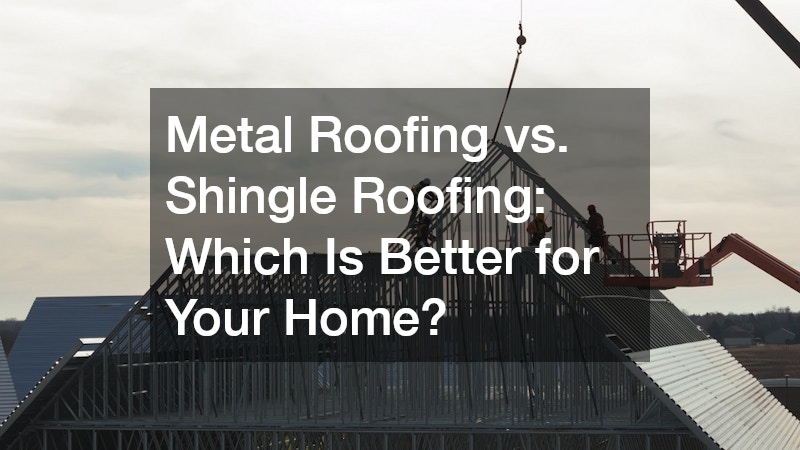
Shingle roofing typically lasts 20 to 30 years, depending on materials and maintenance. While metal roof installation in Wisconsin from Bruce Andrews Seamless Gutters and Roofing provides exceptional durability, shingle roofs continue to be favored for their cost-effectiveness and suitability for milder climates, making them a popular choice among homeowners looking for reliable roofing solutions.
How Does the Cost of Metal Roofing Compare to Shingle Roofing?
Initial Installation Costs
Metal roofing typically has higher upfront costs compared to shingle roofing due to more expensive materials and complex installation requiring specialized skills. However, this initial investment is often justified by its long lifespan and durability.
On the other hand, shingle roofing is more budget-friendly, with lower material and labor costs, making it a popular choice for cost-conscious homeowners. While metal roofing may seem expensive initially, its long-term performance and energy savings can ultimately make it a cost-effective option.
Long-term Cost Considerations
Metal roofing has lower long-term maintenance costs due to its durability, requiring less frequent repairs or replacement than shingle roofs. Its reflective properties can enhance energy efficiency, especially in hot climates, reducing cooling expenses. While shingle roofs are cheaper initially, they often lead to higher long-term costs due to more frequent repairs and a shorter lifespan. Homeowners may find metal roofing appealing despite higher upfront costs, as its durability and energy efficiency can offset expenses over time.
What Are the Durability and Lifespan Differences?
Longevity of Metal Roofing
Metal roofing is known for its exceptional durability and longevity, lasting between 40 and 70 years, with copper often being the longest-lasting option. Factors contributing to this longevity include resistance to rot, mildew, and insects. Additionally, metal roofs effectively shed snow, reducing stress on the structure and minimizing leaks caused by heavy accumulation. Their high wind resistance makes them an ideal choice for areas susceptible to hurricanes and severe storms, ensuring reliable protection for decades.
Longevity of Shingle Roofing
Shingle roofing generally lasts 20 to 30 years, though lifespan can vary based on materials, climate, and maintenance. Regular upkeep can mitigate issues like warping and algae growth. The longevity of a shingle roof is influenced by the quality of the shingles and installation expertise; higher-quality asphalt shingles perform better against weather elements. While not as durable as metal roofs, shingle roofs are popular for their affordability and ease of installation, particularly in milder climates.
How Do Aesthetic and Environmental Factors Compare?
Aesthetic Options for Metal Roofing
Metal roofing offers a wide array of aesthetic options, allowing homeowners to tailor their roofing to match their personal style and home design. Available in a variety of colors and finishes, metal roofs can mimic the look of traditional shingles, tiles, or even wood shakes.
The versatility of metal roofing styles makes it suitable for both contemporary and traditional home designs. Homeowners can choose from standing seam panels, corrugated panels, or tiles in various colors to enhance their home’s curb appeal.
Furthermore, metal roofs can be custom-designed to match unique architectural features, providing a seamless integration with the overall design aesthetics of a home. This flexibility ensures that metal roofing can complement any style while offering superior performance.
Aesthetic Options for Shingle Roofing
Shingle roofing offers a classic look that appeals to many homeowners. Asphalt shingles come in a variety of colors, textures, and styles, providing plenty of options to suit different architectural styles, from traditional to modern designs.
Some shingle options can mimic the appearance of materials such as slate or wood, providing an enhanced aesthetic at a fraction of the cost. This allows homeowners to achieve a high-end look without the associated price tag.
Despite fewer variety options compared to metal roofing, the simplicity and conventional appeal of shingle roofing can significantly enhance the visual appeal of homes, particularly in neighborhoods with a predominant architectural style.
Environmental Impact and Energy Efficiency
Metal roofing is often regarded as an environmentally friendly option due to its potential for recycling and energy efficiency. Metal roofs can be made from recycled materials and are 100% recyclable at the end of their life. Their reflective properties help reduce energy consumption by keeping homes cooler, particularly in sunny climates.
On the other hand, shingle roofing, particularly asphalt shingles, is less environmentally friendly. Shingles are typically made from petroleum-based materials that are not recyclable. Disposal of old shingles poses environmental challenges, contributing to landfill waste.
In terms of energy efficiency, shingle roofs are less effective in reflecting heat compared to metal roofing. However, technological advancements in shingle manufacturing have introduced “cool” shingle options that offer improved reflectivity, although they still lag behind metal roofing in overall energy efficiency.
Conclusion
In conclusion, choosing between metal and shingle roofing requires careful consideration of various factors, including cost, durability, aesthetics, and environmental impact. While metal roofing offers superior longevity and energy efficiency, its higher initial cost may not be suitable for all budgets. Shingle roofing presents a cost-effective alternative with its classic look, but may not offer the same level of durability or environmental benefits.
Ultimately, the decision will depend on individual preferences, regional climate conditions, and budget constraints. Homeowners should weigh the importance of upfront costs against long-term savings and consider the aesthetic appeal and environmental impact of their choice.
By thoroughly assessing these factors, homeowners can make an informed decision that best suits their needs and enhances the value and comfort of their home for years to come.

